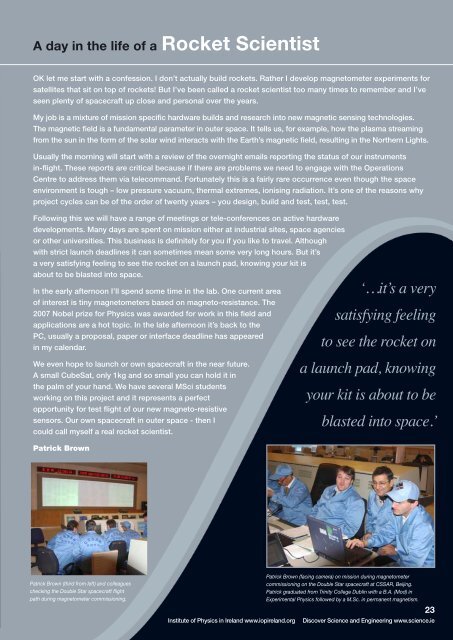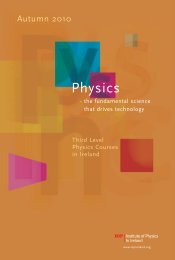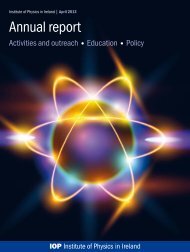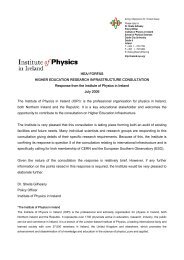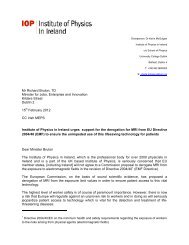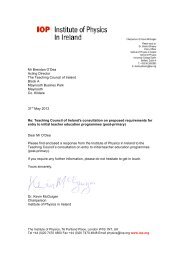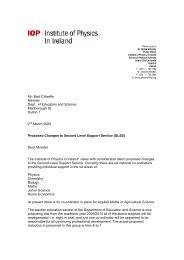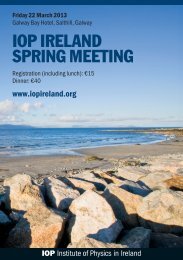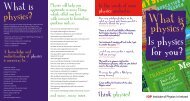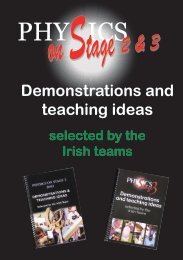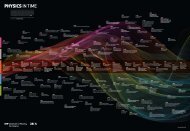28 Days 28 Physicists - The Institute of Physics in Ireland
28 Days 28 Physicists - The Institute of Physics in Ireland
28 Days 28 Physicists - The Institute of Physics in Ireland
Create successful ePaper yourself
Turn your PDF publications into a flip-book with our unique Google optimized e-Paper software.
A day <strong>in</strong> the life <strong>of</strong> a Rocket Scientist<br />
OK let me start with a confession. I don’t actually build rockets. Rather I develop magnetometer experiments for<br />
satellites that sit on top <strong>of</strong> rockets! But I’ve been called a rocket scientist too many times to remember and I’ve<br />
seen plenty <strong>of</strong> spacecraft up close and personal over the years.<br />
My job is a mixture <strong>of</strong> mission specific hardware builds and research <strong>in</strong>to new magnetic sens<strong>in</strong>g technologies.<br />
<strong>The</strong> magnetic field is a fundamental parameter <strong>in</strong> outer space. It tells us, for example, how the plasma stream<strong>in</strong>g<br />
from the sun <strong>in</strong> the form <strong>of</strong> the solar w<strong>in</strong>d <strong>in</strong>teracts with the Earth’s magnetic field, result<strong>in</strong>g <strong>in</strong> the Northern Lights.<br />
Usually the morn<strong>in</strong>g will start with a review <strong>of</strong> the overnight emails report<strong>in</strong>g the status <strong>of</strong> our <strong>in</strong>struments<br />
<strong>in</strong>-flight. <strong>The</strong>se reports are critical because if there are problems we need to engage with the Operations<br />
Centre to address them via telecommand. Fortunately this is a fairly rare occurrence even though the space<br />
environment is tough – low pressure vacuum, thermal extremes, ionis<strong>in</strong>g radiation. It’s one <strong>of</strong> the reasons why<br />
project cycles can be <strong>of</strong> the order <strong>of</strong> twenty years – you design, build and test, test, test.<br />
Follow<strong>in</strong>g this we will have a range <strong>of</strong> meet<strong>in</strong>gs or tele-conferences on active hardware<br />
developments. Many days are spent on mission either at <strong>in</strong>dustrial sites, space agencies<br />
or other universities. This bus<strong>in</strong>ess is def<strong>in</strong>itely for you if you like to travel. Although<br />
with strict launch deadl<strong>in</strong>es it can sometimes mean some very long hours. But it’s<br />
a very satisfy<strong>in</strong>g feel<strong>in</strong>g to see the rocket on a launch pad, know<strong>in</strong>g your kit is<br />
about to be blasted <strong>in</strong>to space.<br />
In the early afternoon I’ll spend some time <strong>in</strong> the lab. One current area<br />
<strong>of</strong> <strong>in</strong>terest is t<strong>in</strong>y magnetometers based on magneto-resistance. <strong>The</strong><br />
2007 Nobel prize for <strong>Physics</strong> was awarded for work <strong>in</strong> this field and<br />
applications are a hot topic. In the late afternoon it’s back to the<br />
PC, usually a proposal, paper or <strong>in</strong>terface deadl<strong>in</strong>e has appeared<br />
<strong>in</strong> my calendar.<br />
We even hope to launch or own spacecraft <strong>in</strong> the near future.<br />
A small CubeSat, only 1kg and so small you can hold it <strong>in</strong><br />
the palm <strong>of</strong> your hand. We have several MSci students<br />
work<strong>in</strong>g on this project and it represents a perfect<br />
opportunity for test flight <strong>of</strong> our new magneto-resistive<br />
sensors. Our own spacecraft <strong>in</strong> outer space - then I<br />
could call myself a real rocket scientist.<br />
Patrick Brown<br />
‘…it’s a very<br />
satisfy<strong>in</strong>g feel<strong>in</strong>g<br />
to see the rocket on<br />
a launch pad, know<strong>in</strong>g<br />
your kit is about to be<br />
blasted <strong>in</strong>to space.’<br />
Patrick Brown (third from left) and colleagues<br />
check<strong>in</strong>g the Double Star spacecraft flight<br />
path dur<strong>in</strong>g magnetometer commission<strong>in</strong>g.<br />
<strong>Institute</strong> <strong>of</strong> <strong>Physics</strong> <strong>in</strong> <strong>Ireland</strong> www.iopireland.org<br />
Patrick Brown (fac<strong>in</strong>g camera) on mission dur<strong>in</strong>g magnetometer<br />
commission<strong>in</strong>g on the Double Star spacecraft at CSSAR, Beij<strong>in</strong>g.<br />
Patrick graduated from Tr<strong>in</strong>ity College Dubl<strong>in</strong> with a B.A. (Mod) <strong>in</strong><br />
Experimental <strong>Physics</strong> followed by a M.Sc. <strong>in</strong> permanent magnetism.<br />
23<br />
Discover Science and Eng<strong>in</strong>eer<strong>in</strong>g www.science.ie


